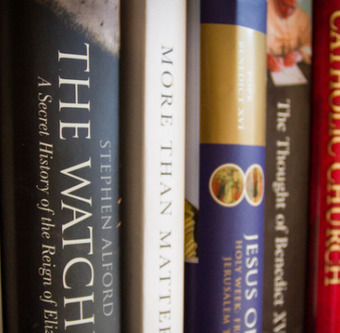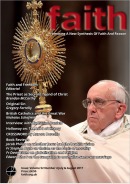
Book Reviews - Did the Saviour See the Father?
Jesus’ beatific vision
Did the Saviour See the Father? by Simon Gaine OP, Bloomsbury, 232pp, £90.00.
reviewed by Jacob Philips
Medieval depictions of the infant Christ are firmly fixed in the Western imagination. Although such depictions are obviously of Jesus as a very small toddler or baby, he tends to sit upright and poised on the Blessed Virgin’s lap, like an adult, with a strikingly all-knowing gaze radiating through his babyish features, centred on a pair of piercingly prescient eyes. The strangely otherworldly or supernatural quality of these images arises of course at least in part from the simple fact that babies and toddlers do not usually sit poised and upright and do not often bear such a knowing wisdom in their eyes.
For the medieval mind, perhaps, these images would not have been quite so jarring as they are to us today, for in the pre-modern era it was believed much more readily that the human being Jesus shared in the direct knowledge of the Father throughout the duration of his earthly life. This direct knowledge is called the beatific vision (visio beatifica), most fully articulated by Thomas Aquinas. For Aquinas, to ‘see’ God directly (meaning not mediated through the created world), means to participate directly in the mind of God. Just as my own self-consciousness is direct and not mediated through what I do or what I have written and so on - I know my own mind directly - so it is, says Aquinas, for all the blessed in heaven, knowing the mind of God in gazing on the Father in unending bliss for all eternity.
A theological volte-face
That the angelic spirits and the souls of the just know the very mind of God has not been subject to much academic disputation and debate. The notion that the man Jesus of Nazareth bore this knowledge in his earthly life, however, is one of the clearest examples of a full-blown theological volte-face in the twentieth century. One could cite many possible causes: modern biology led some to question the possibility that the human brain could ever ‘contain’ such an unimaginable breadth of knowledge; or more commonly, many theologians argued that Christ’s genuine humanity is somehow undermined if he shares in the Father’s own self-knowledge. That is, Hebrews tells us that Jesus is ‘like us in all respects’ (Heb 4.15) and ‘shares in our weaknesses’ (Heb 5.2), and Philippians that he ‘emptied himself taking the form of a servant’ (Phil. 2.7). If Christ is our redeemer through sharing fully in the human lot, surely he needed to have experienced the deeply limited nature of human knowledge: the ambiguity, confusion, misunderstandings, and perplexing situations which constantly arise and assail our lives. From the mid-twentieth century onwards, then, the notion that Christ shared in the beatific vision throughout his earthly life was abruptly but very thoroughly discarded.
Objections
The question: Did the Saviour See the Father? has therefore not really been posed, at least in mainstream Anglophone theology, for some decades. Simon Gaine OP, in his book of the same name, revisits this neglected question for the 21st century, and deals with the main clusters of objections one by one in an impressively structured and lucid work. The issue of whether or not Christ possessed the visio beatifica, in his own words, is whether Jesus by this vision ‘saw not only the essence of God but also all that was, is or will be, in any way whatever, done, thought, or said by all, at any time’ (p. 5). Gaine gives the main loci of objections to this position a chapter each: in Part I, objections based on the contention this is unscriptural, that it is not in the Fathers, or just not good theology; then the more theoretical objections in Part II, that Jesus’ sharing in in the visio undermines his having faith, the need for him to have experienced limited knowledge, his freedom and the depth and magnitude of his suffering.
Did Jesus have faith?
Simon Gaine tackles each set of objections with an admirable level of detail, robust argumentation, and critical rigour. Although this is academic theology at full-throttle, it is important to bear in mind this is an issue which can provoke strong reactions in the pews. Let us take the issue of Jesus having faith. ‘Faith’ is classically defined by Hebrews, again, as ‘the assurance of things hoped for, the conviction of things not seen’ (Heb 11.1). By this definition faith and vision are mutually exclusive, which leaves us in the curious position of holding that Jesus Christ did not possess the theological virtue of faith, the one perfect in his humanity did not share in which the Catechism describes as the ‘virtue by which we believe in God and believe all that he has said and revealed to us’ (§1814). However strange this might seem, Gaine argues convincingly that, not only does the Bible never apportion the verb ‘to believe’ to Christ, but that faith and vision are necessarily mutually exclusive, and all the attempts to find a ‘middle way’ by theologians like Weinandy, O’Collins, Galey and Torrell are ultimately flawed. These discussions leave the reader with a strong sense that Christ’s ‘not having’ faith is not any kind of lack or deficit on his part, for Christ directly knew God and ‘all he has said and revealed to us’.
The overarching value of this book, I suggest, is in reminding us of the value of tradition. This is not something we would expect Catholic theologians to need much reminding of, but Gaine shows clearly how a basic, almost unquestioned aspect of belief maintained for centuries could easily be pushed to the sidelines in a way out of keeping with the accrued wisdom of faith and praxis, and the instincts of the authors of Scripture. Gaine links his concerns here explicitly with Benedict XVI’s commendation of using a ‘hermeneutic of continuity’ in interpreting Vatican II, and this ‘hermeneutic’ thus continues to show itself as capable of bearing fruit beyond the domain of the perpetual Conciliar post-mortem.
Areas of concern
However, let us remember that Benedict XVI also speaks of ‘reform’ within tradition. This consideration might lead us to ask whether Gaine could have added a little more constructive (and less defensive) discussion of how – after the doctrine of Christ having the visio was dropped – our contemporary reengagement with it might be more than a mere retrograde move but an important locus for ongoing theological discovery. Various areas of concern could be dramatically reconfigured if Gaine’s arguments are widely accepted, like interreligious encounters (by affirming Christ’s utter distinctness), universal salvation (by verifying his pronouncements on the ‘narrow gate’), nuptial theology (by challenging the view that his eschatological purview was somehow faulty) and particularly the engagement between theology and neuroscience, which promises to bear much fruit in the years to come.
That said, these observations are not intended to highlight any sins of omission of Gaine’s part, but to point to the considerable depth and value of how his findings might unfold for us today, if we are convinced by his resolute conviction that the Saviour did, indeed, see the Father.
Notes:
Jacob Phillips is a lecturer in theology at St Mary's University, Twickenham





